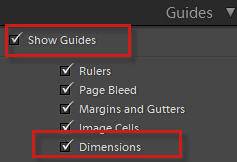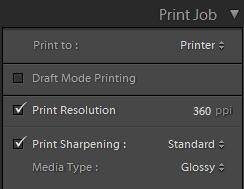“How large can I print my photo?” is a question I get from Lightroom users all the time. The ultimate answer of course is – it depends. In the end you will need to do your own tests and find out what you are satisfied with. Below is some information that should help you with that process. It applies whether you do your own printing, or send your photos out to be printed.
Your photo has a limited number of pixels, or squares of information, in it, based on what your camera captured or what you cropped your photo down to. For example, a capture from an old 6 megapixel camera is 3,000 pixels wide x 2,000 pixels high. (There are various ways to display this information for a photo in Lightroom — try typing “I” once or twice in Library or Develop. Type I again to turn off the information display.)

When you decide on a print size, those available pixels get spread out to fit that print size. Here are some examples from that 6 MP camera:
4″x6″ print: 2,000 pixels / 4″ = 3000 / 6″ = 500 pixels per inch (ppi)
8″x12″ print: 2,000 pixels / 8″ = 250 ppi
16″x24″ print: 2,000 pixels /16″ = 125 ppi
This ppi is called the native resolution of your photo, at the given print size. It is what is inherently, or natively, available to you at the size you plan to print.
But guess what — your printer (or Shutterfly’s or Costco’s or anyone’s) doesn’t print at your photo’s native resolution!! It prints at what it likes to print at — i.e. at its own native resolution. Generally this is 360 ppi for Epson printers, and 300 ppi for HP, Canon and other printers.
Therefore, if your photo has less than 360/300 ppi, more pixels need to be invented. This process is called interpolation, or upsampling.You can have Lightroom do this upsampling before you send the photo to your printer (or printing service), or you can have your printer or service do it. All tests I have seen show that Lightroom does a significantly better job — so have Lightroom do it. (I’ll show you how.)
Lightroom does a great job at this upsampling — it looks at the lines and colors in your photo, and slips in pixels in between all the current ones, to continue those lines and colors.

However, eventually, when you want a really large print, and the native ppi falls way below 360, Lightroom has to invent so much new information that too much error is introduced, and your photo gets fuzzy. (Print output sharpening – which you should do – compensates for this up to a point, but only so far.)
How large can you print your photo before it gets too fuzzy, or in other words, how low of a native photo ppi is too low?
It depends — on expected viewing distance from the print, your printer and paper choice, and you or your viewer’s ability to or interest in discerning fine details.
For myself, given my printer, paper choice, and ability and interest in discerning the fine details, I find that a native photo resolution of 180 ppi is my own lower limit. But do your own tests — print your photo at various sizes, noting the native ppi. (If you can’t print really large at home, you can also take a smaller crop of your photo to start out with fewer pixels.) View the photos from a reasonable viewing distance.
In a workshop I taught last weekend, I showed students the prints of photos with the following native ppi:
- 50 ppi: obviously very blurry — to get from 50 to 360 requires more imagination than even Disney had!
- 150 ppi: they thought it looked decent.
- 300 ppi: once they saw this, they realized that the 150 ppi print was softer — not as crisp, and not as much fine detail preserved.
So how do find out what your photo’s native resolution is, short of getting out a calculator?
In Lightroom’s Print Module:
1. Set up your desired print size (the how-to is beyond the scope of this post).
2. Turn on Dimensions in the Guides panel (4th panel down on the right):

3. Uncheck Print Resolution in the Print Job Panel (last panel on the right)

Now the resolution, in pixels per inch, will display at the top of your print display:

Once you understand your photo’s native resolution, and are ready to go ahead and print, re-check the Print Resolution box in the Print Job panel and set it to your printer’s native resolution (360 for Epson, 300 for HP and Canon). By doing so, you are telling Lightroom to do the upsampling. Leaving this box unchecked will force your printer to do that upsampling, and it just doesn’t do that well.

I would also check Print Sharpening. I am satisfied with the Standard amount — do your own tests with Low and High as well. Set the media type to glossy for any coated paper; matte for any uncoated paper. (Here’s my post on Output Sharpening.)
If you are instead exporting to send to a printing service, you can accomplish the same thing in the Export dialog: specify your size in inches, the resolution your printing service requires (most likely 300), and Output Sharpening.

Experiment and have fun!
Interested in learning how to create great output? Check out my video series, Lightroom 5, 6 and Classic CC: Producing Great Output V. 8 It’s 13 1/2 hours of training in 59 videos, covering all the conceptual output topics that photographers find so confusing, and then how to get great output with the Book, Slideshow, Print, and Web modules.
Related Post:
